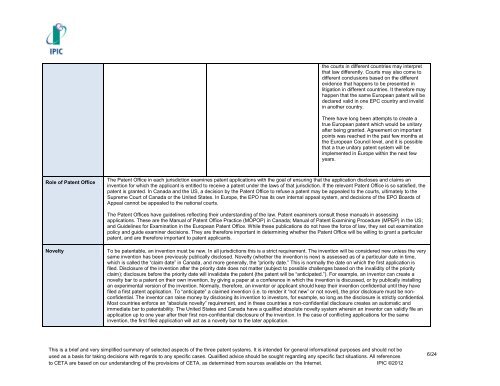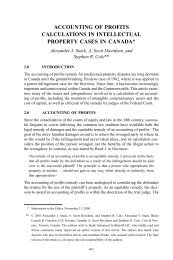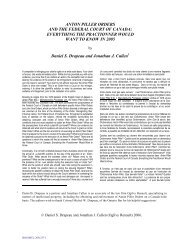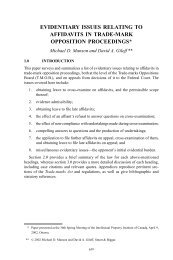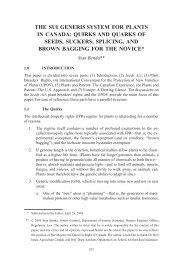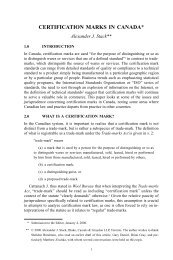A Comparative Overview of Canadian, US and European ...
A Comparative Overview of Canadian, US and European ...
A Comparative Overview of Canadian, US and European ...
You also want an ePaper? Increase the reach of your titles
YUMPU automatically turns print PDFs into web optimized ePapers that Google loves.
Role <strong>of</strong> Patent Office<br />
the courts in different countries may interpret<br />
that law differently. Courts may also come to<br />
different conclusions based on the different<br />
evidence that happens to be presented in<br />
litigation in different countries. It therefore may<br />
happen that the same <strong>European</strong> patent will be<br />
declared valid in one EPC country <strong>and</strong> invalid<br />
in another country.<br />
There have long been attempts to create a<br />
true <strong>European</strong> patent which would be unitary<br />
after being granted. Agreement on important<br />
points was reached in the past few months at<br />
the <strong>European</strong> Council level, <strong>and</strong> it is possible<br />
that a true unitary patent system will be<br />
implemented in Europe within the next few<br />
years.<br />
The Patent Office in each jurisdiction examines patent applications with the goal <strong>of</strong> ensuring that the application discloses <strong>and</strong> claims an<br />
invention for which the applicant is entitled to receive a patent under the laws <strong>of</strong> that jurisdiction. If the relevant Patent Office is so satisfied, the<br />
patent is granted. In Canada <strong>and</strong> the <strong>US</strong>, a decision by the Patent Office to refuse a patent may be appealed to the courts, ultimately to the<br />
Supreme Court <strong>of</strong> Canada or the United States. In Europe, the EPO has its own internal appeal system, <strong>and</strong> decisions <strong>of</strong> the EPO Boards <strong>of</strong><br />
Appeal cannot be appealed to the national courts.<br />
The Patent Offices have guidelines reflecting their underst<strong>and</strong>ing <strong>of</strong> the law. Patent examiners consult these manuals in assessing<br />
applications. These are the Manual <strong>of</strong> Patent Office Practice (MOPOP) in Canada; Manual <strong>of</strong> Patent Examining Procedure (MPEP) in the <strong>US</strong>;<br />
<strong>and</strong> Guidelines for Examination in the <strong>European</strong> Patent Office. While these publications do not have the force <strong>of</strong> law, they set out examination<br />
policy <strong>and</strong> guide examiner decisions. They are therefore important in determining whether the Patent Office will be willing to grant a particular<br />
patent, <strong>and</strong> are therefore important to patent applicants.<br />
Novelty To be patentable, an invention must be new. In all jurisdictions this is a strict requirement. The invention will be considered new unless the very<br />
same invention has been previously publically disclosed. Novelty (whether the invention is new) is assessed as <strong>of</strong> a particular date in time,<br />
which is called the “claim date” in Canada, <strong>and</strong> more generally, the “priority date.” This is normally the date on which the first application is<br />
filed. Disclosure <strong>of</strong> the invention after the priority date does not matter (subject to possible challenges based on the invalidity <strong>of</strong> the priority<br />
claim); disclosure before the priority date will invalidate the patent (the patent will be “anticipated.”). For example, an inventor can create a<br />
novelty bar to a patent on their own invention, by giving a paper at a conference in which the invention is discussed, or by publically installing<br />
an experimental version <strong>of</strong> the invention. Normally, therefore, an inventor or applicant should keep their invention confidential until they have<br />
filed a first patent application. To “anticipate” a claimed invention (i.e. to render it “not new” or not novel), the prior disclosure must be nonconfidential.<br />
The inventor can raise money by disclosing its invention to investors, for example, so long as the disclosure is strictly confidential.<br />
Most countries enforce an “absolute novelty” requirement, <strong>and</strong> in these countries a non-confidential disclosure creates an automatic <strong>and</strong><br />
immediate bar to patentability. The United States <strong>and</strong> Canada have a qualified absolute novelty system wherein an inventor can validly file an<br />
application up to one year after their first non-confidential disclosure <strong>of</strong> the invention. In the case <strong>of</strong> conflicting applications for the same<br />
invention, the first filed application will act as a novelty bar to the later application.<br />
This is a brief <strong>and</strong> very simplified summary <strong>of</strong> selected aspects <strong>of</strong> the three patent systems. It is intended for general informational purposes <strong>and</strong> should not be<br />
used as a basis for taking decisions with regards to any specific cases. Qualified advice should be sought regarding any specific fact situations. All references<br />
WSLegal\049190\00037\8068137v1<br />
to CETA are based on our underst<strong>and</strong>ing <strong>of</strong> the provisions <strong>of</strong> CETA, as determined from sources available on the Internet. IPIC ©2012<br />
6/24


